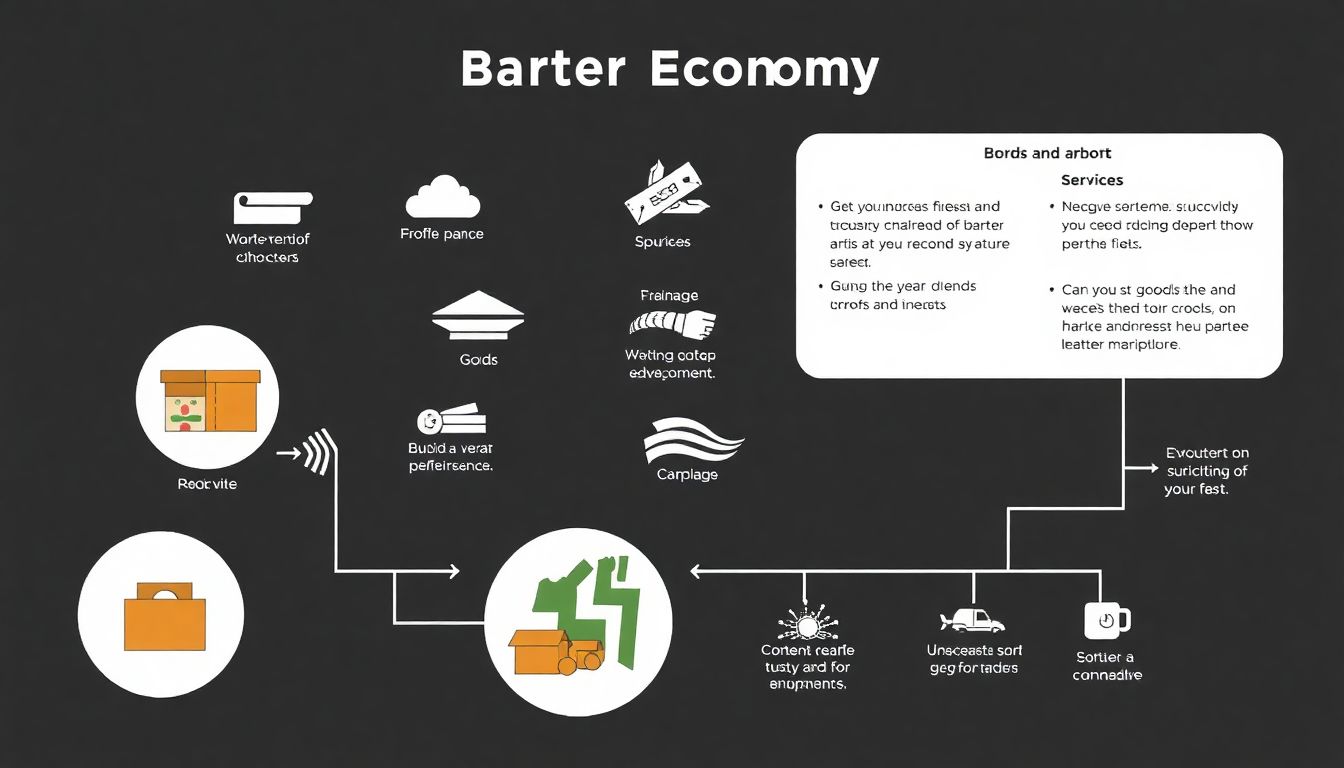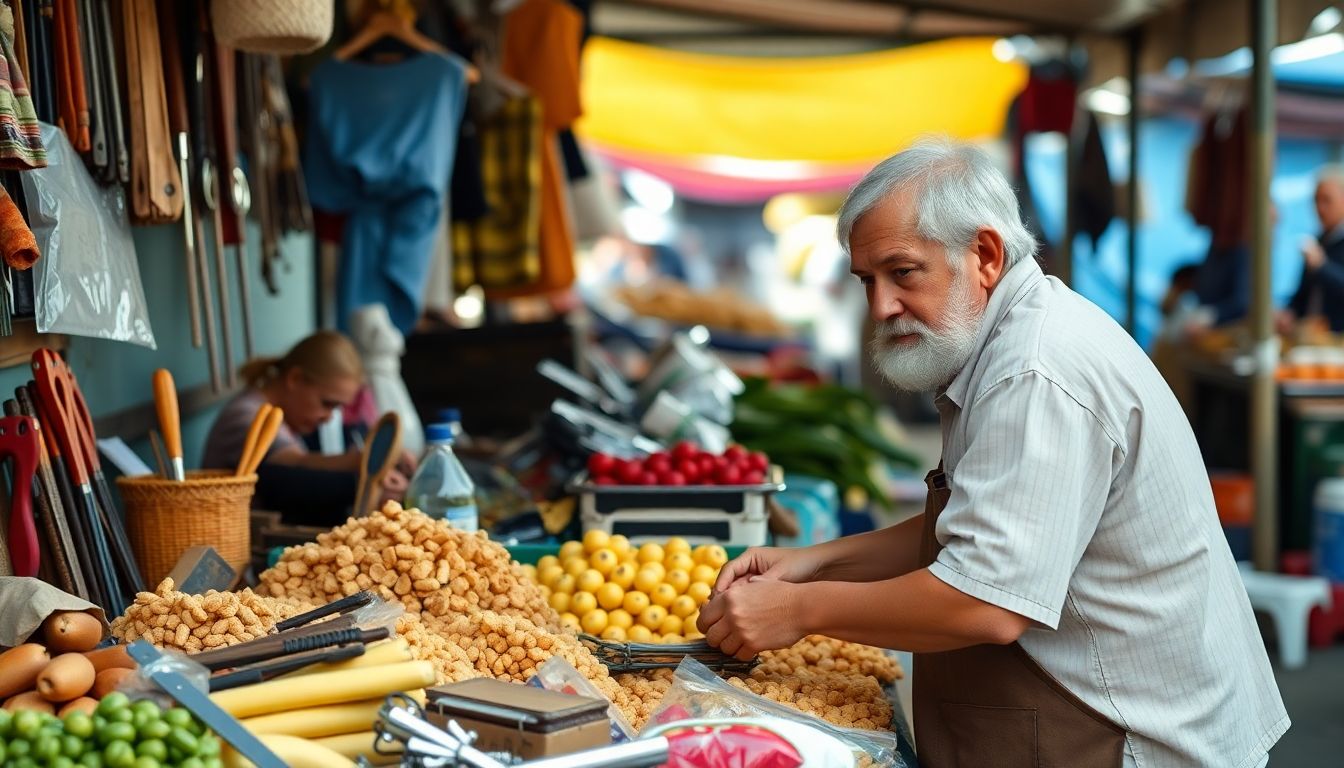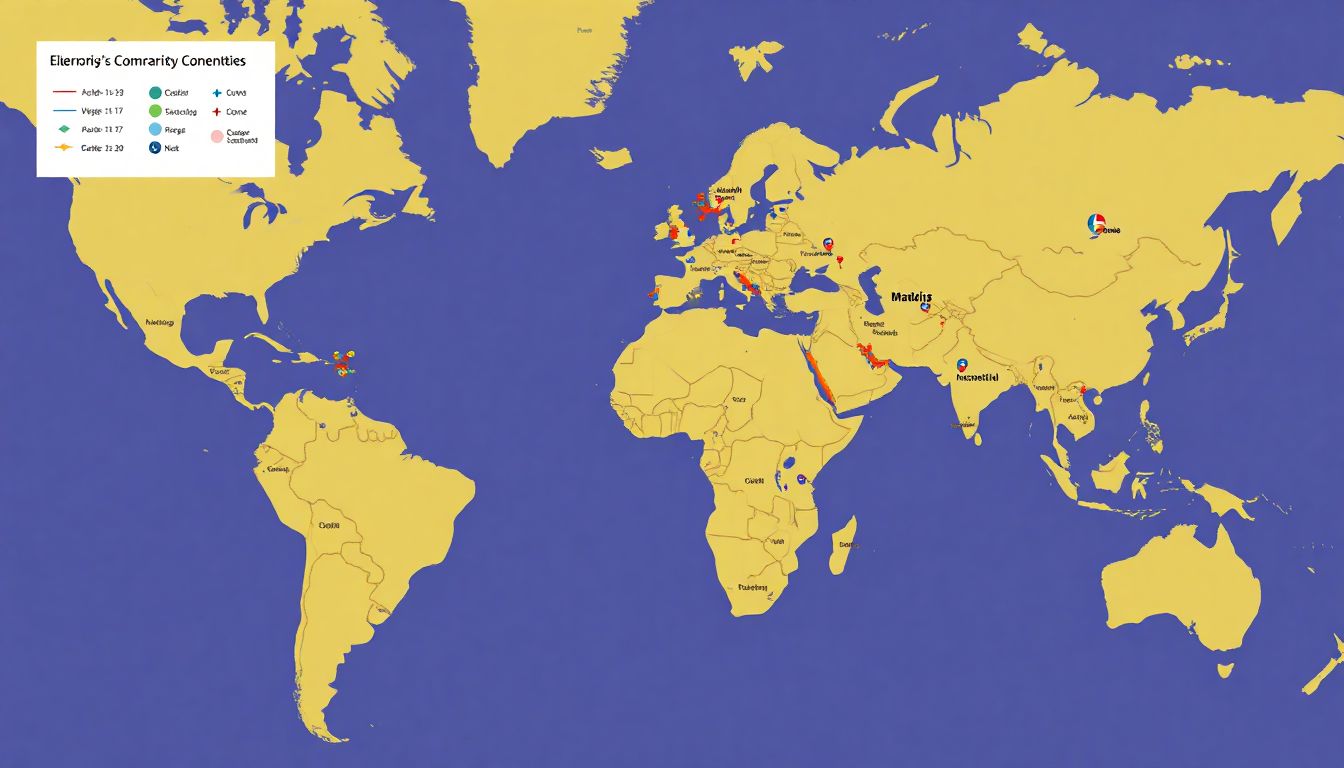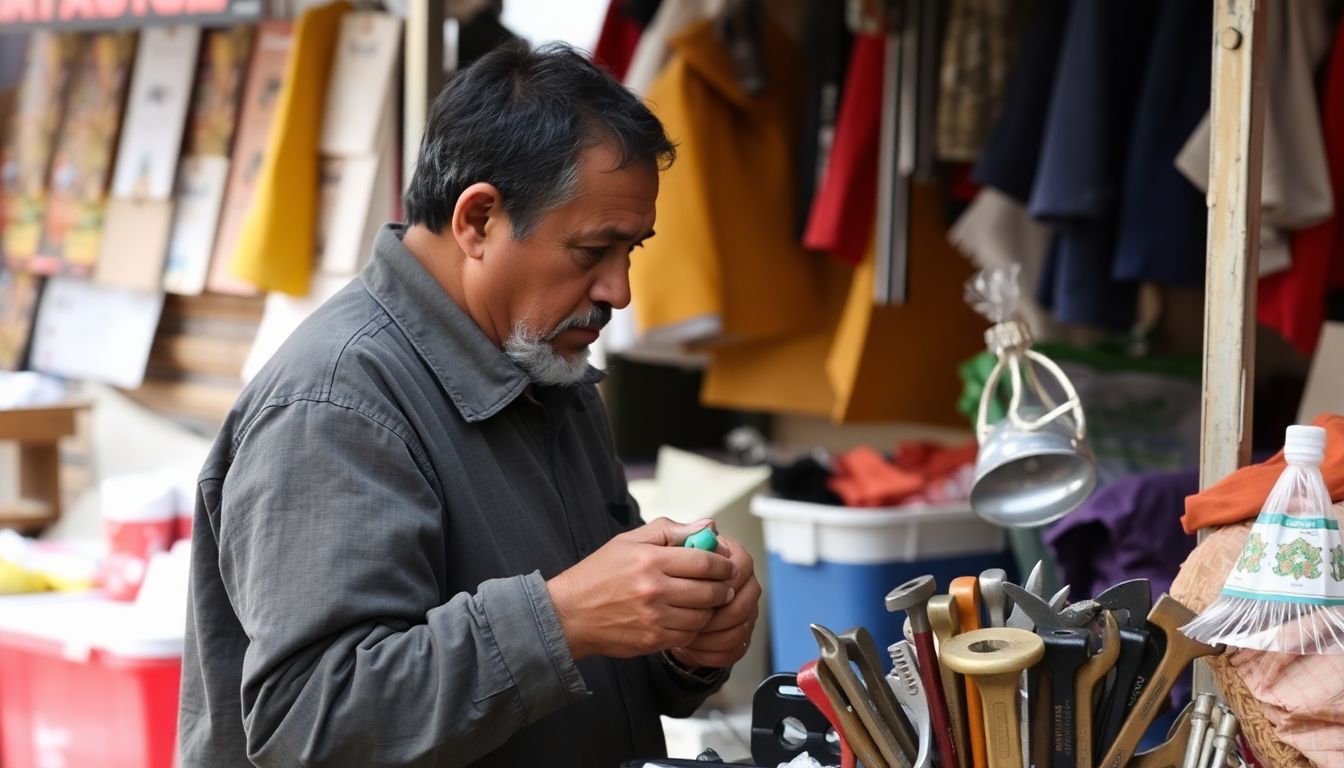In the dynamic dance of economies, one constant remains: the exchange of value. But what happens when the music stops, and the currency we’ve come to rely on loses its rhythm? This is where the art of bartering takes center stage, a skill as old as civilization itself, and one that could very well be the lifeline in a post-collapse economy. But what are these ‘trade goods’ and ‘valuable skills’ that will hold sway in such a world? And how can you, dear reader, prepare for an economic landscape that may look vastly different from what we know today?
Let’s agree on one thing: the global economy is a complex beast, prone to unexpected shifts and sudden collapses. History is riddled with examples
- from the Great Depression to the more recent 2008 financial crisis. Now, more than ever, it’s crucial to consider the ‘what ifs’ and prepare for the unexpected. This article promises to equip you with the knowledge and tools necessary to navigate a post-collapse economy, focusing on the valuable skills and trade goods that could become the new currency.
Imagine this: the power grid goes down, not for a few hours, but indefinitely. ATMs are silent, banks closed, and your digital wallet is as useful as a paperweight. Cash is scarce, and credit cards are mere plastic. What do you have to offer? What do you need? And how do you get it? This is where the preview of our journey comes in. We’ll delve into the world of bartering, exploring the skills and items that could become invaluable in a post-collapse economy. From first aid to farming, from soap to solar panels, we’ll discuss the ‘trade goods’ that could keep you afloat in challenging times. We’ll also explore the ‘valuable skills’ that could make you a sought-after member of any community, from plumbing to teaching, from cooking to coding.
So, are you ready to step into the world of bartering? To explore the skills and items that could become your lifeline in a post-collapse economy? Then read on, for what you learn here could very well shape your future. Let’s embark on this journey together, armed with curiosity, open minds, and a healthy dose of preparedness.
Thriving in an Economic Shift: Valuable Skills and Essential Items for Survival
In the dynamic dance of economies, shifts are inevitable, and with them, the need for adaptability and preparedness. Imagine the global stage as a grand chessboard, where pawns are jobs, knights are industries, and the king, the overall economic health. As the pieces move, some strategies become obsolete, while new ones emerge, shining like hidden treasures. Thriving in such a shift requires a keen eye, a flexible mind, and a well-stocked toolbox. The skills that will serve you best are not merely those that fill your resume, but those that make you resilient, versatile, and forward-thinking. These include the ability to learn and adapt quickly, to communicate effectively, to problem-solve creatively, and to collaborate seamlessly. Essential items for survival in this economic landscape are not just material possessions, but knowledge, networks, and a positive mindset. It’s about having the right information at the right time, being connected to the right people, and maintaining an optimistic outlook even in the face of uncertainty. After all, every shift brings opportunities, and being prepared is the key to turning them into realities. So, as the economic winds change, let’s not just weather the storm, but learn to dance in the rain, equipped with valuable skills and essential items, ready to thrive.

Understanding the Barter Economy
In the vast tapestry of economic systems, the barter economy stands as a timeless and intriguing concept. At its core, a barter economy is a system where goods and services are exchanged directly, without the use of a medium of exchange like money. This is not a modern phenomenon, but rather a system that has been in practice since ancient times, predating the use of currency.
The advantages of a barter economy are manifold. Firstly, it eliminates the need for a central authority to issue and manage currency, making it a decentralized system that can operate independently of governments or financial institutions. This can be particularly beneficial in post-collapse scenarios, where traditional financial systems may be disrupted or non-existent. Secondly, bartering allows for a more direct and immediate exchange of value. If a baker needs a new pair of shoes, they can trade their bread directly with a cobbler, rather than using an intermediary currency. This can lead to a more efficient allocation of resources, as people can trade based on their immediate needs and skills.
However, a barter economy also has its challenges and differs significantly from traditional currency-based systems. One of the main challenges is the issue of double coincidence of wants. This refers to the need for two parties to both want what the other has to offer at the same time. If the baker needs shoes but the cobbler needs wheat, a direct trade is not possible. This can limit the flexibility and scalability of a barter economy. Additionally, barter systems can be less stable than currency-based systems, as they rely on the subjective value that individuals place on goods and services.
In post-collapse scenarios, the barter economy can play a crucial role. When traditional financial systems fail, people often revert to bartering as a means of survival. This can help to maintain economic activity and facilitate the exchange of goods and services, even in the absence of a formal currency. However, it’s important to note that barter economies are not a panacea and can face significant challenges in such scenarios.
In conclusion, the barter economy is a fascinating and complex system that has played a significant role in human history. While it has its advantages and can be a valuable tool in post-collapse scenarios, it also has its limitations and challenges. Understanding the barter economy can provide valuable insights into the nature of economic systems and the role that they play in society.

Essential Bartering Skills
Bartering, an ancient practice that’s making a comeback in today’s sharing economy, is more than just exchanging goods or services. It’s an art that requires a unique blend of skills to ensure a successful and satisfying transaction. Let’s delve into the essential skills needed for successful bartering. Understanding Value: The Bartering Compass The first step in any bartering journey is understanding the value of what you’re offering and what you’re after. This isn’t just about monetary value, but also the time, effort, and skill that went into creating or acquiring the item or service. For instance, a handmade pottery piece might not fetch the same price as a mass-produced one, but its unique craftsmanship and personal touch give it a value that can’t be quantified by price tags alone. To understand value, research similar items or services, consider their unique qualities, and be open to the idea that value is subjective and can vary greatly from person to person. Negotiation: The Art of Give and Take Negotiation is the heart of bartering. It’s about finding a middle ground where both parties feel they’ve gained something. Start by asking open-ended questions to understand the other person’s needs and wants. Perhaps they’re looking for something specific, or maybe they’re open to suggestions. Be clear about what you’re offering and why it’s valuable. Remember, the goal is not to ‘win’ the negotiation, but to find a mutually beneficial agreement. For example, if you’re a graphic designer looking to barter for organic produce, instead of offering a fixed rate, ask the farmer about their needs. They might need a new logo, a website, or promotional materials. By understanding their needs, you can tailor your offer and find a win-win situation. Building Trust: The Bartering Bond Trust is the currency that oils the wheels of bartering. It’s about building relationships, not just making transactions. Before any exchange, do your homework. Research the person or business you’re dealing with. Check their online presence, ask for references, or ask around in your community. Once you’ve established trust, maintain it by being reliable, honest, and transparent. If you can’t deliver what you promised, communicate openly and early. Trust is built over time, but it can be lost in an instant. So, always strive to act in good faith. For instance, if you’re a baker looking to barter for childcare services, meet the potential caregiver in a public place, ask for references, and discuss your needs and expectations openly. Communication: The Bartering Bridge Clear, concise, and respectful communication is key in any bartering transaction. It’s about listening actively, expressing yourself clearly, and being open to feedback. Use ‘I’ statements to express your needs and feelings, and avoid making assumptions. For example, instead of saying ‘You always overcharge for your services,’ say ‘I feel that the price you quoted is higher than I expected. Can we discuss this further?’ Good communication turns potential conflicts into opportunities for understanding and growth. Patience and Persistence: The Bartering Marathon Bartering isn’t always easy or quick. It often involves patience and persistence. Don’t be discouraged if you don’t find the right trade immediately. Keep looking, keep communicating, and keep learning. The more you barter, the better you’ll get at it. And remember, every ‘no’ brings you one step closer to a ‘yes.’ In essence, successful bartering is about more than just exchanging goods or services. It’s about understanding value, negotiating fairly, building trust, communicating clearly, and being patient and persistent. It’s about creating a community of exchange where everyone benefits. So, go forth, bartering adventurers, and happy trading!

Identifying Valuable Trade Goods
In the dynamic and unpredictable landscape of a post-collapse economy, identifying valuable trade goods is not just an art, but a critical survival skill. The importance of versatile, durable, and essential items cannot be overstated in such an environment. These goods serve as the lifeblood of barter systems, enabling communities to rebuild and thrive despite the challenges posed by societal breakdowns.
The first category of valuable trade goods comprises items that are versatile, serving multiple purposes and thus maximizing their utility. For instance,
- multitool pocket knives
- paracord
- duct tape
are invaluable due to their versatility. A multitool can serve as a knife, pliers, a screwdriver, and more, while paracord can be used for everything from securing a tent to making a belt. Duct tape, on the other hand, can temporarily fix almost anything, from broken glasses to punctured water bottles.
Durability is another key factor in determining the value of trade goods. Items that can withstand the test of time and wear are highly sought after in a post-collapse economy. Examples include
- stainless steel cookware
- high-quality boots
- metal water bottles
. These items may be more expensive in a pre-collapse world, but their longevity makes them worth the investment in a post-collapse scenario.
Lastly, essential items are those that are crucial for survival and well-being. These include
- medical supplies
- seeds for gardening
- water purification tablets
. While these items may not be as exciting as, say, a new gadget, they are the true gold standard in a post-collapse economy. They can mean the difference between life and death, and thus, they hold immense value.
Understanding and recognizing the value of these trade goods is not just about amassing a collection of useful items. It’s about building a network of trust and mutual aid, fostering a sense of community, and ultimately, ensuring the survival and resilience of society in the face of collapse.

The Art of Diversification
In the dynamic tapestry of commerce, the art of diversification stands as a beacon of resilience and prosperity. By spreading one’s trade goods and skills across a broad spectrum, individuals and businesses can navigate the ebb and flow of markets with remarkable agility. This strategic approach, much like a well-balanced investment portfolio, mitigates risk and maximizes opportunities.Diversification, in its essence, is a safeguard against market fluctuations. When one trade good or skill faces a downturn, others may be thriving, ensuring a steady stream of income. For instance, consider the case of the Renaissance merchant, Francesco di Marco Datini. He traded in a wide array of goods, from textiles to spices, and his diverse portfolio allowed him to weather economic storms that would have decimated a less diversified trader.To achieve this art, several strategies can be employed. Firstly,
- identify your core competencies and expand from there. If you’re skilled in carpentry, consider branching into related fields like furniture design or woodturning.
- Keep an eye on emerging markets and trends. As new opportunities arise, be ready to adapt and incorporate them into your repertoire.
- Network extensively. Building relationships with other traders and artisans can open doors to new markets and collaborations.
Secondly, it’s crucial to understand your customer base. Diversifying your offerings based on their evolving needs and preferences can lead to increased customer loyalty and satisfaction. Take, for example, the case of the Etsy seller who started with handmade jewelry but diversified into custom pet portraits and upcycled home decor as she understood her customers’ appreciation for unique, personalized items.Lastly, remember that diversification is not a one-time effort but an ongoing process. Markets change, and so should your offerings. Stay flexible, stay informed, and above all, stay curious. The art of diversification, after all, is a journey, not a destination.

Bartering in the Digital Age
In the digital age, bartering, an ancient practice of exchanging goods and services without the use of money, has evolved significantly with the advent of technology. Online marketplaces have emerged as digital town squares, facilitating transactions between individuals and businesses worldwide. These platforms, such as Craigslist, Facebook Marketplace, and Etsy, allow users to list items they wish to trade, making the process of finding compatible barters more efficient than ever.
Digital currencies, including cryptocurrencies like Bitcoin and Ethereum, have also breathed new life into bartering. These decentralized, digital assets enable transactions between parties without the need for traditional banking systems. They offer several advantages, including reduced transaction fees, increased privacy, and the ability to trade across borders with ease.
However, these modern methods of bartering are not without their challenges. Online marketplaces often struggle with trust issues, as users must rely on reviews and ratings to assess the credibility of potential trading partners. Additionally, the lack of a central authority can make disputes difficult to resolve. Digital currencies, while promising, are also volatile and subject to regulatory uncertainty, which can deter some potential users.
Moreover, the digital divide, the gap between those with access to technology and those without, can exacerbate existing inequalities in bartering. Those without internet access or digital literacy may be left behind, unable to participate in the digital barter economy.
Despite these challenges, the potential of technology to transform bartering is immense. As online marketplaces continue to grow and digital currencies become more mainstream, we may see a future where bartering plays a more significant role in our economies. The key will be to address the challenges and ensure that the benefits of digital bartering are equitably distributed.

Bartering Networks and Communities
In the grand tapestry of human interaction, bartering networks and communities have long been woven as vital threads, facilitating exchange and cooperation. These networks, where goods and services are traded without the use of currency, hold immense importance in today’s interconnected world. They foster a sense of community, promote sustainability, and encourage the exchange of unique skills and products.
Building and maintaining such networks requires a blend of vision, planning, and continuous engagement. Here are some tips to help you create and sustain these communities:
- Identify Shared Interests: Begin by finding people who share similar passions or needs. This could be anything from organic farming to coding, or from childcare to DIY projects.
- Establish Clear Guidelines: Set out rules for the barter system, such as how to value goods and services, how to handle disputes, and how to ensure fairness.
- Encourage Diversity: Aim for a diverse mix of skills and resources within your network. This ensures a wide range of items and services can be exchanged.
- Foster Trust and Communication: Regular meetups, online forums, or newsletters can help build trust and keep everyone informed about what’s available and who’s offering what.
- Promote Continuous Learning and Growth: Encourage members to learn new skills and share their knowledge with others. This not only enriches the network but also makes it more resilient.
Remember, maintaining a bartering network is an ongoing process. It requires patience, flexibility, and a commitment to the community’s well-being. With time and nurturing, these networks can grow into vibrant, self-sustaining communities that enrich the lives of all involved.

Bartering with Services
In a barter economy, services play a pivotal role, often serving as a medium of exchange when goods are scarce or unavailable. Services, intangible yet valuable, can range from professional skills like plumbing or legal advice to personal services such as childcare or pet sitting. Let’s explore some valuable services and how to barter them effectively.
Consider a skilled plumber, Bob, who lives in a community where bartering is common. Bob has a unique skill set that is always in demand. He could barter his plumbing services for a variety of goods or other services. For instance, he might trade a leak repair for a week’s worth of fresh produce from a local farmer, or a full-day plumbing service for a haircut and color from the community’s hairstylist.
To barter services effectively, follow these steps:
- Identify Your Skills and Services: Start by assessing your unique skills and services. These could be professional services like Bob’s plumbing, or personal services like cooking, teaching, or even emotional support.
- Determine Their Value: Next, estimate the value of your services. This could be based on the time spent, the complexity of the task, or the demand for your specific skill in your community.
- Research Demand: Understand what services are in demand in your community. This could be anything from home repairs to tech support, depending on the needs of your neighbors.
- Network and Communicate: Lastly, network within your community. Let people know what services you offer and be open to discussing potential trades. Clear communication is key to ensuring both parties feel they’re getting a fair deal.
Remember, the key to effective service bartering is finding a balance where both parties feel they’ve gained something of equal value. It’s a delicate dance, but with the right mindset and a little creativity, it can lead to a thriving, self-sustaining community.

Bartering in Times of Scarcity
In times of scarcity, when traditional currencies lose their value or become scarce themselves, bartering emerges as a lifeline, a means to acquire necessities and maintain a sense of community. However, bartering in such times is not without its challenges. The most pressing is the lack of a universally accepted medium of exchange. In a barter system, every transaction must involve a direct exchange of goods or services, making it less flexible than monetary transactions. For instance, a farmer with a surplus of crops might find it difficult to exchange them for services like medical care or education, as the latter are not easily divisible or perishable like the former.
Another challenge is the issue of specialization and division of labor. In times of scarcity, people often revert to subsistence farming or basic crafts, leading to a loss of the intricate division of labor that characterizes modern societies. This makes it harder to find people with specialized skills to barter with.
Despite these challenges, bartering in times of scarcity has been successful in many instances, thanks to creative strategies and community cooperation. One such example is the barter system that emerged in Cuba after the collapse of the Soviet Union. Faced with severe shortages of goods, Cubans resorted to bartering, leading to a thriving underground economy. People exchanged everything from food and clothing to services like haircuts and home repairs. The system was so successful that it led to the creation of a parallel currency, the ‘dollar,’ which was used alongside the official peso.
Survival stories from such times often highlight the importance of adaptability and community spirit. In the Great Depression, for example, many Americans turned to bartering to survive. They formed ‘barter clubs’ where members exchanged goods and services, from food and clothing to auto repairs and legal services. These clubs not only helped people survive economically but also fostered a sense of community and mutual support.
In conclusion, while bartering in times of scarcity presents unique challenges, it also offers a lifeline to communities, fostering a sense of interdependence and mutual support. It is a testament to human adaptability and resilience, proving that even in the face of severe hardship, people can find ways to survive and thrive.

Bartering and the Law
Bartering, an ancient practice of exchanging goods and services without the use of money, has seen a resurgence in recent times, driven by economic uncertainties and a growing interest in sustainable living. However, this age-old system is not without its legal intricacies. The law plays a pivotal role in maintaining a fair and equitable barter economy, ensuring that both parties involved in a transaction are protected and that the system remains transparent and accountable.
The legal landscape of bartering is a complex web of regulations that vary significantly from one jurisdiction to another. In many places, bartering is subject to the same laws that govern traditional sales, including consumer protection and fair trading practices. This means that barters must be conducted in good faith, with both parties disclosing any defects or issues with the goods or services being exchanged.
At the heart of any barter transaction is a contract, whether it’s explicit or implied. This contract outlines the terms of the exchange, including what is being traded, the value of each item, and any conditions attached to the transaction. It’s crucial for both parties to understand and agree to these terms to avoid disputes. In some cases, a written contract may be necessary to protect both parties’ interests.
Dispute resolution is another critical aspect of the legal framework surrounding bartering. When disagreements arise, parties can seek recourse through various means, including negotiation, mediation, or in some cases, litigation. Some barter systems have their own dispute resolution processes, while others may rely on the general legal system. The key is to have a fair and efficient process in place to resolve disputes promptly and amicably.
In conclusion, while bartering offers a unique and often rewarding way to exchange goods and services, it’s essential to understand the legal aspects involved. By doing so, we can help maintain a fair and thriving barter economy, where everyone feels protected and confident in their transactions.
FAQ
What are some valuable skills for a post-collapse economy?
- farming and gardening,
- hunting and fishing,
- medical knowledge,
- basic construction and repair,
- mechanical and electrical skills,
- leatherworking and textiles,
- woodworking and carpentry,
- metalworking,
- animal husbandry,
- food preservation,
- and teaching or leadership skills.
How can I determine the value of my skills in a barter economy?
- the demand for your skillset,
- the rarity of your skills,
- the time and effort required to learn and practice your skills,
- the potential impact of your skills on others’ survival and well-being,
- and the value of the goods or services you can produce or provide using your skills.
For example, a skilled doctor or nurse will be highly valued, while a common laborer may not be as sought after.
What are some examples of trade goods in a post-collapse economy?
- food and water,
- seeds and plants,
- clothing and textiles,
- shelter materials and tools,
- medical supplies and herbs,
- fuel and energy sources,
- weapons and self-defense items,
- jewelry and precious metals,
- art and decorative items,
- and knowledge or information, such as books, maps, or specialized skills.
How can I barter effectively in a post-collapse economy?
- Research and understand the local economy and demand for goods and services,
- Be patient and willing to negotiate,
- Be honest and transparent about the quality and condition of your goods,
- Consider trading in bundles or packages to increase the perceived value,
- Be open to creative and non-monetary forms of exchange, such as services or favors,
- Build relationships and trust with other traders,
- Keep detailed records of your trades to avoid disputes,
- And be prepared to adapt and adjust your trading strategies as the economy evolves.
What role do luxury goods play in a post-collapse economy?
- serve as a form of currency or investment,
- provide a sense of normalcy and comfort in difficult times,
- stimulate trade and economic activity,
- and foster social bonds and community through gift-giving and sharing.
Additionally, luxury goods can be used to barter for other goods or services, as they may hold more value than practical items in certain situations.
How can I protect myself and my goods in a post-collapse economy?
- Building a strong and diverse network of trusted friends and allies,
- Establishing clear boundaries and rules for trade and exchange,
- Keeping your goods and skills discreet to avoid attracting unwanted attention,
- Carrying weapons or other means of self-defense,
- Storing goods securely and in multiple locations,
- Being cautious of strangers and potential threats,
- And maintaining a low profile to avoid becoming a target for theft or violence.
How can I prepare for a post-collapse economy now?
- Learning and practicing essential survival skills,
- Acquiring useful tools and equipment,
- Building a network of like-minded individuals and communities,
- Storing food, water, and other essential supplies,
- Investing in precious metals or other durable assets,
- Developing a deep understanding of local ecosystems and resources,
- And maintaining physical fitness and overall health.
Additionally, staying informed about current events and potential threats can help you anticipate and adapt to changing circumstances.









